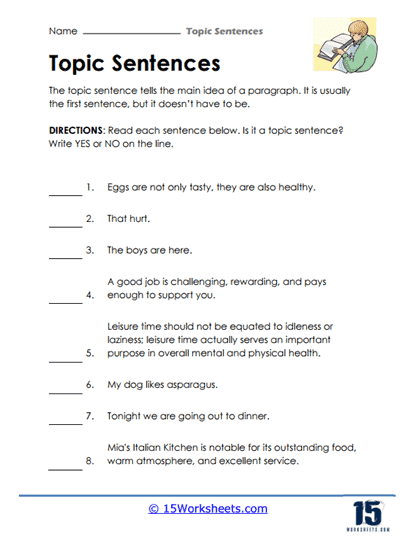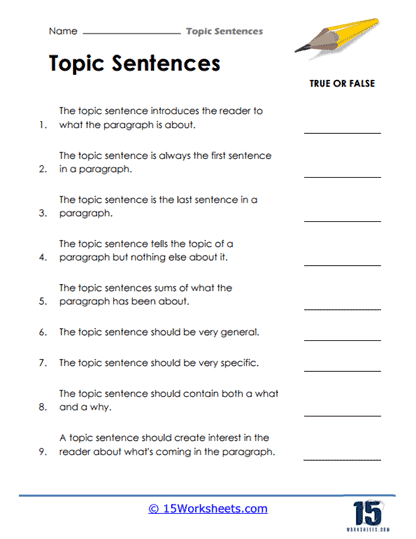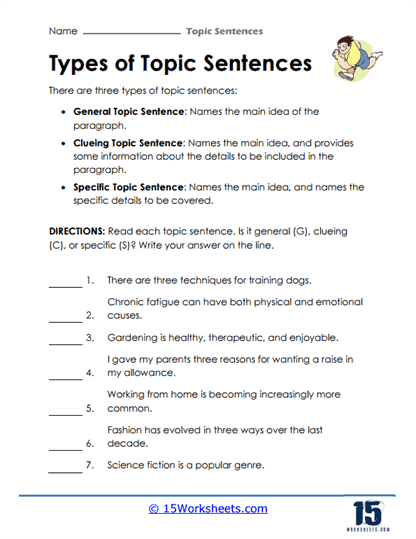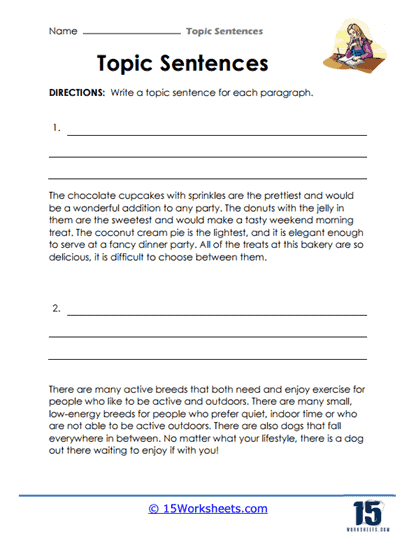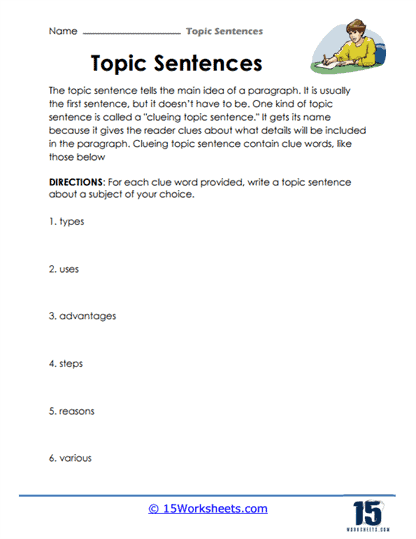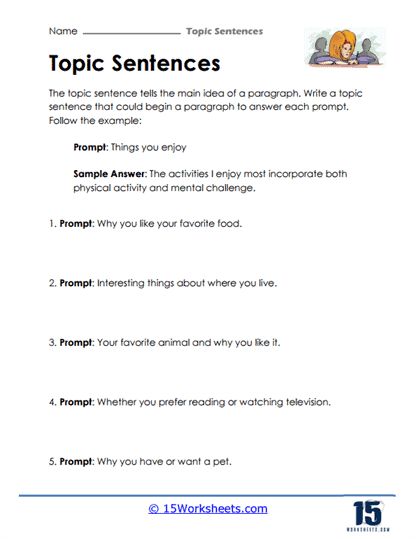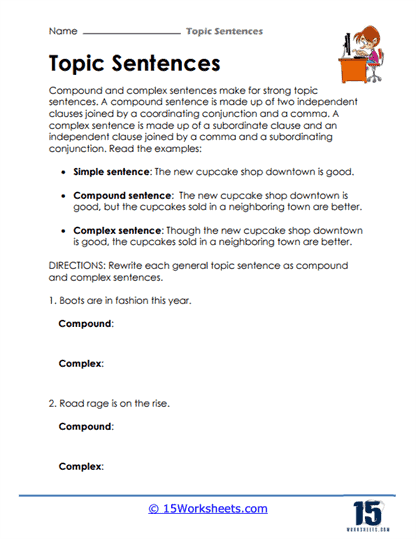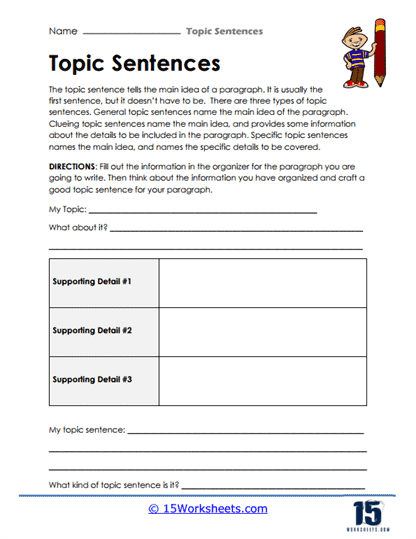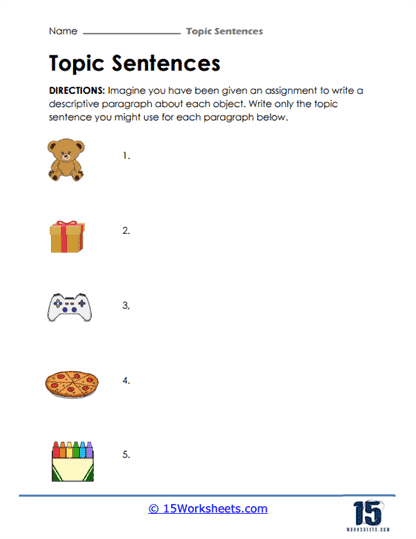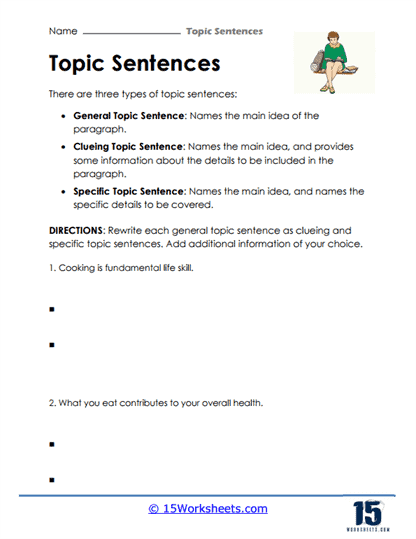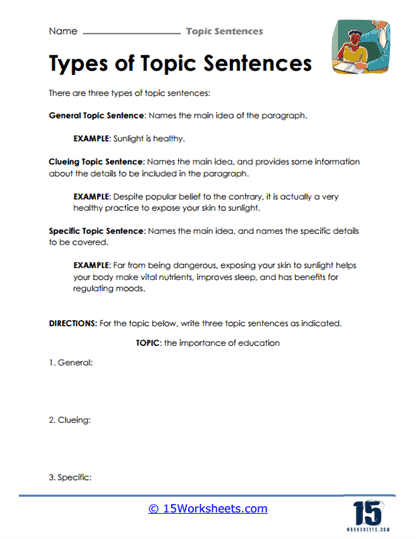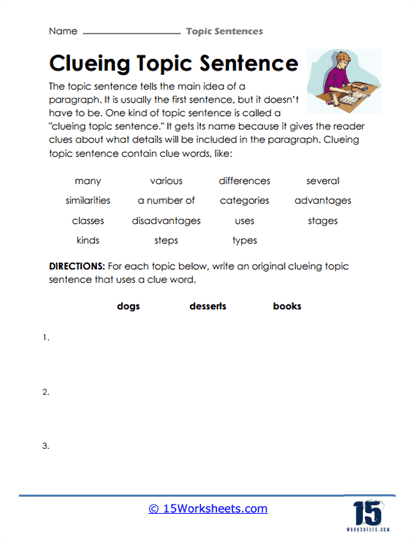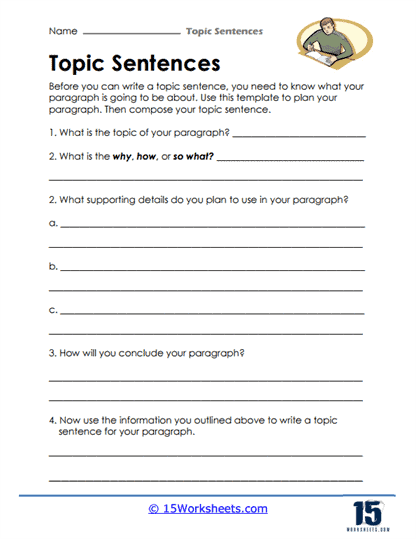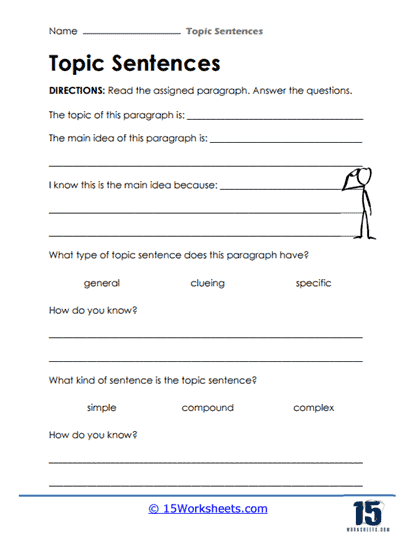Topic Sentences Worksheets
All About These 15 Worksheets
Topic sentence worksheets will help individuals, particularly students, develop and improve their ability to identify, write, and understand topic sentences in a piece of writing. A topic sentence is the main idea or central point of a paragraph, and it often appears at the beginning of the paragraph. It sets the tone and direction for the rest of the content by summarizing what the paragraph will be about. Worksheets focused on topic sentences typically include exercises that ask learners to identify topic sentences in a given text, create their own topic sentences for paragraphs, or differentiate between strong and weak topic sentences. These exercises are often a crucial part of language arts education, especially in teaching writing structure and organization.
One of the main ways topic sentence worksheets can be helpful is by improving reading comprehension. When readers can easily identify the topic sentence of a paragraph, they are better able to understand the main idea and purpose of that paragraph. This skill is particularly useful when reading longer texts or articles, where recognizing the key ideas quickly can significantly enhance comprehension. Worksheets that provide practice in identifying topic sentences train students to look for clues about what a paragraph is going to discuss, which is a fundamental reading strategy.
Topic sentence worksheets are valuable for enhancing writing skills. Writing a clear and effective topic sentence is a vital part of creating well-organized paragraphs. When students practice writing their own topic sentences, they learn how to express the main idea concisely and ensure that all the following details in the paragraph support that idea. Worksheets may include exercises where students are given a set of details or a list of supporting sentences, and they have to come up with a strong topic sentence to tie them all together. These activities encourage logical thinking and coherence in writing, both of which are important in academic and professional communication.
These worksheets are also helpful in reinforcing critical thinking skills. By comparing strong and weak topic sentences, learners can understand the characteristics that make a topic sentence effective, such as clarity, specificity, and relevance. For example, worksheets might ask students to improve weak or vague topic sentences by making them more precise or aligned with the details of the paragraph. This process helps students think critically about the relationships between ideas and how best to communicate those relationships in writing.
These worksheets follow a swell of different aspects to help students better understand these topics including:
Explanation and Examples – These worksheets provide an explanation of what a topic sentence is and its importance in writing. They often include examples to illustrate how a topic sentence introduces and encapsulates the main idea of a paragraph or essay.
Identifying Topic Sentences – Students are presented with paragraphs or short passages and are asked to identify the topic sentence within them. This exercise helps students understand how topic sentences stand out and guide the overall structure of the writing.
Creating Them – Worksheets may provide prompts, pictures, or scenarios that require students to generate their own topic sentences. This practice encourages students to think critically and express the central idea concisely.
Revising and Improving Them – Some worksheets focus on revising and improving existing topic sentences. Students are given topic sentences that may be weak, unclear, or lacking in focus, and they are tasked with revising them to make them stronger and more effective.
Applying Topic Sentences in Writing – These worksheets include writing exercises where students are prompted to write paragraphs or essays based on given topics. They must include a strong topic sentence that clearly presents the main idea of their writing.
How Does This Benefit Students?
Understanding Paragraph Structure – Topic sentence worksheets help students grasp the importance of topic sentences in organizing and structuring their writing. They learn that topic sentences serve as guideposts for readers and create a logical flow within paragraphs.
Developing Writing Skills – Practice with topic sentences improves students’ ability to express their ideas clearly and concisely. It encourages them to think critically about the main idea they want to convey in their writing.
Coherence and Unity – Worksheets assist students in understanding the connection between topic sentences and supporting details within a paragraph. They learn how topic sentences unify the content and ensure coherence in their writing.
Critical Thinking – Creating and revising topic sentences require students to analyze the main idea, consider the audience, and select the most appropriate wording. This exercise enhances their critical thinking and decision-making skills.
What is a Topic Sentence?
A topic sentence is the main sentence in a paragraph that summarizes the central idea or point the paragraph will discuss. It acts as a guide for the reader, indicating what to expect in the sentences that follow. Typically, the topic sentence is the first sentence of a paragraph, though it can sometimes appear in the middle or even the end. It directly supports the thesis statement of an essay or a broader argument by introducing a specific point that contributes to the overall argument or idea. In doing so, it helps maintain a logical flow and coherence within the writing.
A good topic sentence is clear and concise, focusing on a single idea that can be elaborated upon in the rest of the paragraph. The supporting sentences that follow provide examples, evidence, or further explanations to back up the idea presented in the topic sentence. While the topic sentence often reveals the paragraph’s subject, it also may indicate the writer’s stance or attitude toward the topic. By crafting a strong topic sentence, writers ensure that their paragraphs are well-organized and effectively contribute to the essay’s overall purpose.
How to Write a Topic Sentence
The first step in writing a high-quality topic sentence is to have a clear understanding of the paragraph’s main idea or focus. Before writing, ask yourself: what is the key point I want to convey in this paragraph? The topic sentence should encapsulate this point in a concise manner. It’s important to ensure that the topic sentence relates directly to the thesis or main argument of the larger piece of writing. A well-crafted topic sentence does not merely state a fact but introduces an idea that the paragraph will explore in more depth, setting the stage for the supporting evidence that follows.
Be Clear and Specific
A high-quality topic sentence should be clear and specific, giving the reader a precise idea of what the paragraph will discuss. Vague or overly broad sentences can confuse the reader or make the paragraph feel unfocused. To avoid this, focus on a single point or idea rather than trying to introduce multiple concepts at once. For instance, instead of saying, “Many factors affect climate change,” a more focused topic sentence would be, “Human activities, such as burning fossil fuels and deforestation, are the primary contributors to climate change.” The latter is specific and sets a clear direction for the paragraph.
Connect to the Thesis
The topic sentence should not exist in isolation but should tie back to the essay’s overall thesis or argument. Every paragraph in a well-structured essay should support the central thesis, and the topic sentence helps achieve that by framing the paragraph in relation to the larger argument. For example, if your essay’s thesis is about the importance of renewable energy, a good topic sentence might be, “Solar power offers a viable alternative to fossil fuels because it is sustainable and increasingly affordable.” This sentence connects directly to the larger theme of renewable energy and primes the reader for evidence and discussion that will follow.
Make It Engaging
A great topic sentence not only informs but also engages the reader’s interest. This can be achieved by using strong and active language, asking a question, or presenting a surprising fact or statistic. For example, a topic sentence like, “Why do some societies thrive while others struggle?” immediately grabs attention and invites the reader to think more deeply. An engaging topic sentence encourages the reader to continue reading with interest and curiosity, ensuring they remain engaged with the content of the paragraph.

